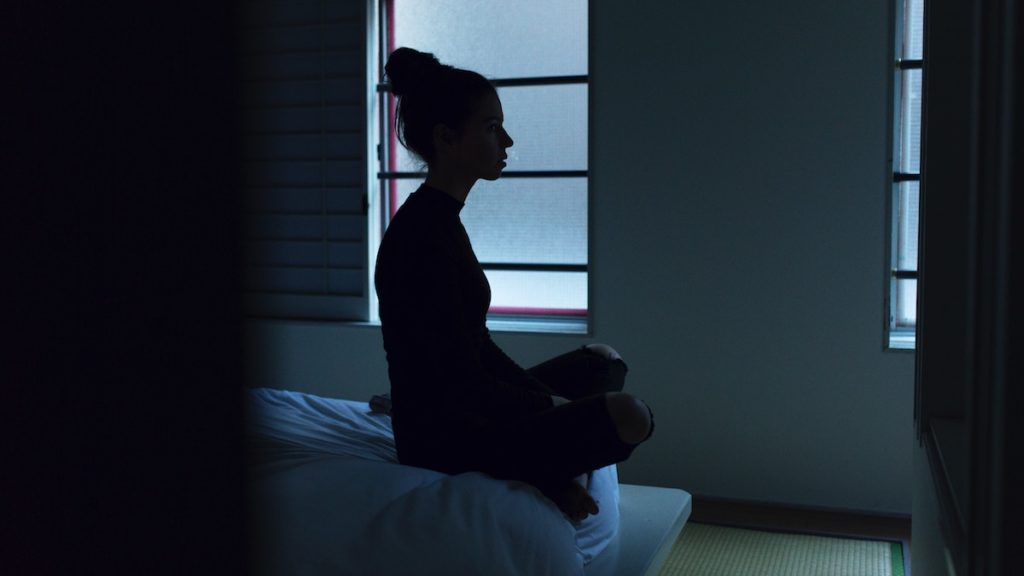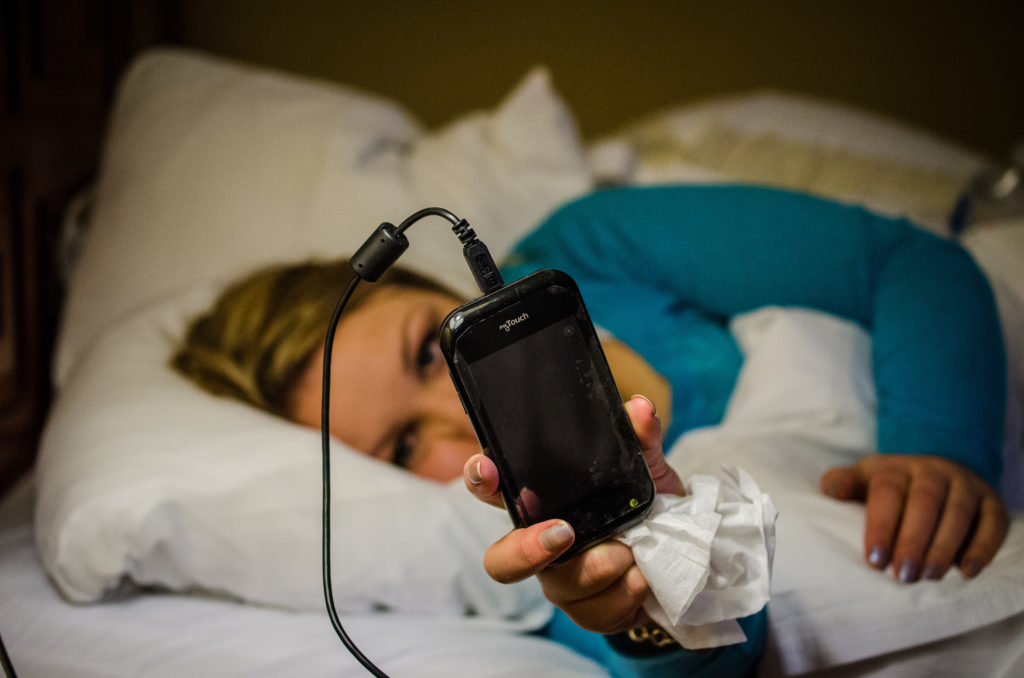
Technology is the recognised enemy of sleep. Our eyes are ritualistically illuminated by the glow of social media, the constant flash of notifications and by emails which seemingly can’t wait until morning. It should not be surprising that our love of technology can interfere with sleep, but it might be surprising to consider that technology could also be its saviour.
Regardless of the cause, difficulties falling, staying or getting sufficient sleep are a big problem for society as a whole. As many as 30% of adults struggle with their sleep and around 18% of adolescents meet the diagnostic criteria for insomnia. This is a big issue. Sleep problems are associated with mental health difficulties, risk for dementia, obesity and difficulties in concentration and alertness. Society is beginning to wake up to this issue, but effective interventions for insomnia and sleep difficulties are needed.
Cognitive behavioural therapy for insomnia (CBTi) targets the psychological causes of insomnia such as poor sleep habits (e.g. using smartphones and working in the bedroom) and negative beliefs about sleep (e.g. expecting sleep to be difficult or impossible to achieve). However, despite its efficacy it comes with similar problems that other psychological therapies face; namely access to trained therapists and the associated costs.
This is where the dichotomy of technology solving a problem it helped create comes in. Digitally delivered interventions are being hailed as a step-forward in health care and insomnia is no different. Digitally delivered CBTi, or eCBTi, is available primarily online via web-based clients or smartphones and it allows the key features of CBTi to be delivered with limited contact from a trained therapist.
When eCBTi has been trialed in adults it has been shown to be at least as effective as face to face interventions, but it is still not clear whether the same can be said for adolescents – the generation who grew up with a smartphone in their hand. This is where the recent open-access review by Aliza Werner-Seidler, Lara Johnston and Helen Christensen from the University of New South Wales, Black Dog Institute comes in. They asked whether the current trials examining the use of eCBTi in adolescents showed it to be an effective intervention, as it has been in adults.

Society is beginning to wake up to the importance of sleep, but can digital interventions help with insomnia and sleep difficulties?
Methods
This was a systematic review conducted using PRISMA guidelines. The authors searched three separate databases (Embase, Medline, and PsycINFO), and the journal Internet Interventions, and used the following inclusion criteria:
- Articles published from the year the world wide web was launched (Jan 1991) until the present day
- The interventions targeted insomnia or individual sleep variables (e.g. sleep duration, time taken to fall asleep)
- Comprised a sample of participants aged between 12-24 years old
- Contained at least two core elements of CBTi
- Comprised an intervention which was delivered at least 75% digitally (e.g. smartphone or web-based).
A risk of bias for RCTs was also incorporated to identify any sources of bias needing to be considered to accurately interpret the results.
Results
According to the PRISMA flow diagram, 6,876 studies were screened from the three databases. Out of these, 31 texts were assessed at the full-text level and finally 3 (de Bruin et al., 2014; 2015; Morris et al., 2015) were identified as relevant to the questions posed by this review.
Firstly, most participants in each study completed all sessions of eCBTi (11/13 in de Bruin et al. 2014; 38/39 in de Bruin et al. 2015; and unknown for Morris et al. 2015).
De Bruin et al. (2014)
- Pilot study (N=13)
- Compared pre-vs-post scores and against face-to-face delivered CBTi
- For the pre-versus-post intervention comparisons:
- There was an increase in objectively measured sleep efficiency, a decrease in wake after sleep onset, and a reduction in sleep onset latency
- There was an increase in subjectively measured sleep efficiency and a decrease in wake after sleep onset, time in bed and sleep onset latency
- There were no significant differences between eCBTi and face-to-face CBTi.
De Bruin et al. (2015)
- RCT which compared eCBTi (n=39) against waitlist control (n=39) and group face-to-face CBTi
- For the post-intervention scores compared to the waitlist control:
- Objectively measured sleep efficiency, sleep onset latency and total sleep time were shown to be improved
- Only the improvements in sleep efficiency and sleep onset latency were maintained at 2-month follow-up
- Subjectively measured sleep efficiency and sleep onset latency were shown to be improved and maintained at 2-month follow-up
- Sleep quality showed an improvement
- There was no significant change in wake after sleep onset, time in bed or total sleep time in this study
- There were no significant differences in outcomes for the eCBTi and the CBTi interventions.
Morris et al. (2015)
- RCT which compared eCBTi (n=48) against waitlist control (n=47).
- At post-intervention and follow-up, there was an improvement in sleep quality compared to the waitlist control group
- There were no significant effects for depression or anxiety, but the effect sizes were moderate in size.
Risk of bias
- Lack of control group for de Bruin (2014) but it was conducted as a pilot study
- Unclear whether all sleep outcomes were reported in Morris (2015) as trial was not pre-registered. No explanation for why participants dropped out in this trial either
- By contrast, de Bruin et al. (2015) study was pre-registered with a protocol published prior to completion of the trial.

All three studies showed a positive impact of eCBTi on sleep variables and the effect sizes were large in some instances.
Conclusions
The results from this systematic review are limited by the small number of studies conducted in this age group, but nonetheless the evidence seems to support a positive role of eCBTi to treat sleep problems in young people. All three studies showed a positive impact of eCBTi on sleep variables and the effect sizes were large in some instances. Equally important, from the limited data available, it seems that eCBTi was well tolerated by the insomnia samples, with the majority of participants completing all sessions.
Interestingly, there was also shown to be a benefit for eCBTi over face-to-face delivered CBTi. This is particularly relevant as it suggests that besides eCBTi removing barriers to treatment for tech-savvy adolescents, it might also be more beneficial (or at least as good) as therapist-driven interventions.

From the limited data available, it seems that eCBTi was well tolerated by people with insomnia with most people completing all sessions in this research studies.
Strengths and limitations
The review is small in that only three studies were identified, but this says more about the infancy of this field rather than shortcomings of the review. The researchers were thorough in their searches and included major databases, an additional journal specialising in internet interventions, and explored reference lists and citations of the articles identified. It could be argued that this review did not explore unpublished studies or trials, which may have shown negative findings for electronic CBTi.
However, the researchers included a risk of bias analysis specifically addressing the issues pertinent to their research question. The review was pre-registered with Prospero and conducted using PRISMA guidelines which are in place to increase the rigour of systematic reviews.

This is a well conducted review, but our knowledge about the efficacy and safety of eCBTi for insomnia in young people is limited by the small number of trials.
Implications for practice
Digital health is a growing area which is certainly not limited to sleep difficulties such as insomnia, but this review shows the promise of using electronically delivered CBTi to help adolescents and young adults with sleep problems. It is too early to be using these interventions as part of standard care based on this review alone, but it supports further research in this population. It was particularly interesting to see that the positive effects on sleep were seen for both those with a clinical diagnosis of insomnia and a self-selecting healthy sample (Morris et al., 2015).
The one study (Morris et al., 2015) examining mental health outcomes failed to show an effect for mental health outcomes such as depression and anxiety. However, there is ongoing work looking at how treating insomnia can improve mental health in adolescent samples (Freeman et al., 2017). The effects of treating sleep on mental health outcomes was small, but alongside the positive results of this review, it appears that eCBTi could have implications for sleep and mental health if integrated into standard care.
The ease with which automated and electronic sleep therapies could be delivered opens up the promise of a powerful tool to improve the mental (and physical) health of a population vulnerable to mental health difficulties. In an age where technology is being blamed for poor sleep, it seems paradoxical to think that the same technology (e.g. smartphones) can be used to improve sleep habits in adolescents. Yet, even for sleep, it seems as though digitally delivered interventions hold promise to help those who are waiting for face-to-face treatment.

This review shows that digital delivered CBT for insomnia may be a useful option for people currently waiting for face-to-face treatment, but further research is needed to confirm these findings.
Conflicts of interest
None to report.
Links
Primary paper
Werner-Seidler, A., Johnston, L., & Christensen, H. (2018). Digitally-delivered cognitive-behavioural therapy for youth insomnia: A systematic review. Internet Interventions, 11, 71-78.
Other references
de Bruin EJ, Oort FJ, Bogels SM, Meijer AM. (2014) Efficacy of internet and group-administered cognitive behavioral therapy for insomnia in adolescents: a pilot study. Behav. Sleep Med., 12 (2014), pp. 235-254, 10.1080/15402002.2013.784703
de Bruin EJ, Bogels SM, Oort FJ, Meijer AM. (2015) Efficacy of cognitive behavioral therapy for insomnia in adolescents: a randomized controlled trial with internet therapy, group therapy and a waiting list condition. Sleep, 38 (2015), pp. 1913-1926, 10.5665/sleep.5240
Morris J, Firkins A, Millings A, Mohr C, Redford P, Rowe A. (2016) Internet-delivered cognitive behavior therapy for anxiety and insomnia in a higher education context. Anxiety Stress Coping, 29 (2016), pp. 415-431, 10.1080/10615806.2015.1058924
Freeman D et al. (2017) The effects of improving sleep on mental health (OASIS): a randomised controlled trial with mediation analysis. The Lancet Psychiatry Published: 06 September 2017 Open Access DOI: http://dx.doi.org/10.1016/S2215-0366(17)30328-0
Insomnia, paranoia and hallucinations: Sleepio CBTi at the OASIS
Photo credits
- Photo by Victoria Heath on Unsplash
- Photo by Ben Blennerhassett on Unsplash
- Photo by Jordan Whitt on Unsplash
- Photo by Cassandra Hamer on Unsplash
- Photo by Ferenc Horvath on Unsplash
- m01229 CC BY 2.0
